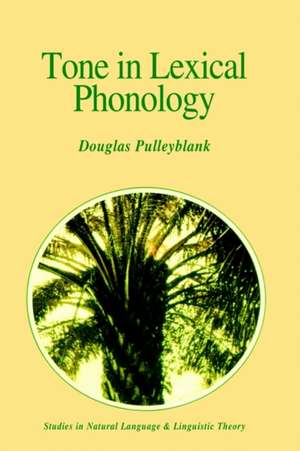Tone in Lexical Phonology: Studies in Natural Language and Linguistic Theory, cartea 4
Autor Douglas Pulleyblanken Limba Engleză Hardback – 30 iun 1986
| Toate formatele și edițiile | Preț | Express |
|---|---|---|
| Paperback (1) | 943.25 lei 6-8 săpt. | |
| SPRINGER NETHERLANDS – 30 iun 1986 | 943.25 lei 6-8 săpt. | |
| Hardback (1) | 949.42 lei 6-8 săpt. | |
| SPRINGER NETHERLANDS – 30 iun 1986 | 949.42 lei 6-8 săpt. |
Din seria Studies in Natural Language and Linguistic Theory
- 24%
 Preț: 808.06 lei
Preț: 808.06 lei - 18%
 Preț: 788.72 lei
Preț: 788.72 lei - 18%
 Preț: 958.56 lei
Preț: 958.56 lei - 15%
 Preț: 600.26 lei
Preț: 600.26 lei - 18%
 Preț: 947.67 lei
Preț: 947.67 lei - 15%
 Preț: 646.62 lei
Preț: 646.62 lei - 18%
 Preț: 723.56 lei
Preț: 723.56 lei - 15%
 Preț: 604.84 lei
Preț: 604.84 lei - 18%
 Preț: 952.09 lei
Preț: 952.09 lei - 15%
 Preț: 642.51 lei
Preț: 642.51 lei - 18%
 Preț: 947.50 lei
Preț: 947.50 lei - 15%
 Preț: 646.75 lei
Preț: 646.75 lei - 18%
 Preț: 1224.54 lei
Preț: 1224.54 lei - 15%
 Preț: 641.71 lei
Preț: 641.71 lei - 18%
 Preț: 2314.56 lei
Preț: 2314.56 lei - 18%
 Preț: 952.89 lei
Preț: 952.89 lei - 18%
 Preț: 1220.12 lei
Preț: 1220.12 lei - 15%
 Preț: 642.83 lei
Preț: 642.83 lei - 18%
 Preț: 944.19 lei
Preț: 944.19 lei - 15%
 Preț: 648.05 lei
Preț: 648.05 lei - 18%
 Preț: 952.57 lei
Preț: 952.57 lei - 18%
 Preț: 1729.61 lei
Preț: 1729.61 lei - 15%
 Preț: 644.95 lei
Preț: 644.95 lei - 15%
 Preț: 644.63 lei
Preț: 644.63 lei -
 Preț: 384.48 lei
Preț: 384.48 lei - 18%
 Preț: 1662.85 lei
Preț: 1662.85 lei - 18%
 Preț: 955.08 lei
Preț: 955.08 lei - 18%
 Preț: 952.40 lei
Preț: 952.40 lei -
 Preț: 386.81 lei
Preț: 386.81 lei
Preț: 949.42 lei
Preț vechi: 1157.82 lei
-18% Nou
Puncte Express: 1424
Preț estimativ în valută:
181.67€ • 197.96$ • 153.08£
181.67€ • 197.96$ • 153.08£
Carte tipărită la comandă
Livrare economică 23 aprilie-07 mai
Preluare comenzi: 021 569.72.76
Specificații
ISBN-13: 9789027721235
ISBN-10: 9027721238
Pagini: 262
Ilustrații: XII, 249 p.
Dimensiuni: 210 x 297 x 20 mm
Greutate: 0.56 kg
Ediția:1986
Editura: SPRINGER NETHERLANDS
Colecția Springer
Seria Studies in Natural Language and Linguistic Theory
Locul publicării:Dordrecht, Netherlands
ISBN-10: 9027721238
Pagini: 262
Ilustrații: XII, 249 p.
Dimensiuni: 210 x 297 x 20 mm
Greutate: 0.56 kg
Ediția:1986
Editura: SPRINGER NETHERLANDS
Colecția Springer
Seria Studies in Natural Language and Linguistic Theory
Locul publicării:Dordrecht, Netherlands
Public țintă
ResearchCuprins
one: Introduction.- 1. Lexical Phonology.- 2. Tiered Phonology.- 3. Tone and Lexical Phonology.- Two: The Relevance of Downstep for a Phonetic Component.- 1. Introduction.- 2. Some General Properties of Downstep.- 3. The Overall Model.- 4. Downstep in Tiv: Evidence for Floating L-tones.- 5. Downstep in Dschang: More Evidence for Floating Tones.- 6. Post-lexical vs. Phonetic Rules.- Notes.- Three: Morphological Encoding and the Association Conventions.- 1. Introduction.- 2. The Cycle.- 3. Association Conventions.- 4. Morphological Encoding — Alternative Approaches.- Four: Underspecification.- 1. Introduction.- 2. Default Rules.- 3. Yala Ikom Reduplication.- 4. Yoruba.- 5. Values for Default Rules.- 6. Constraints on Underspecification.- 7. Ordering of Default Rules.- 8. Referring to Free Skeletal Positions.- 9. Core Values vs. Autosegments.- 10. Conclusion.- Notes.- Five: Accent.- 1. Introduction.- 2. Diacritics.- 3. Melodies.- 4. Tonga.- 5. Conclusion.- Notes.- Six: Rule Properties.- 1. Introduction.- 2. Prelinking.- 3. Extratonality: the Case of Margi.- 4. Polarity.- 5. Assignment of Rules to Components.- Notes.- References.- Index of Languages.- Index of Names.- Index of Subjects.


















